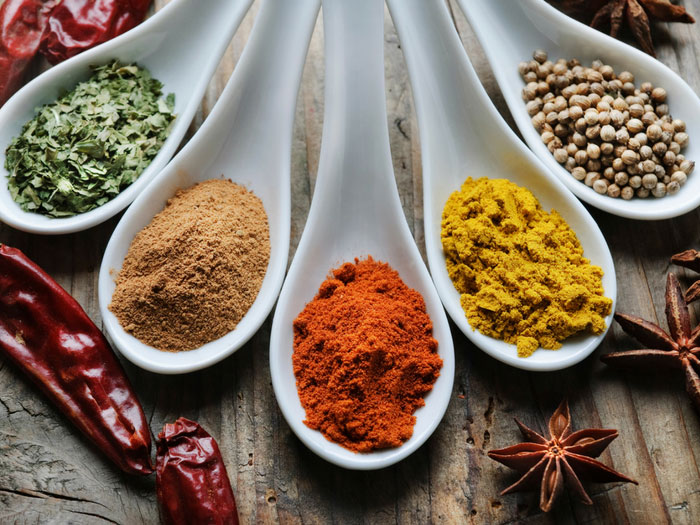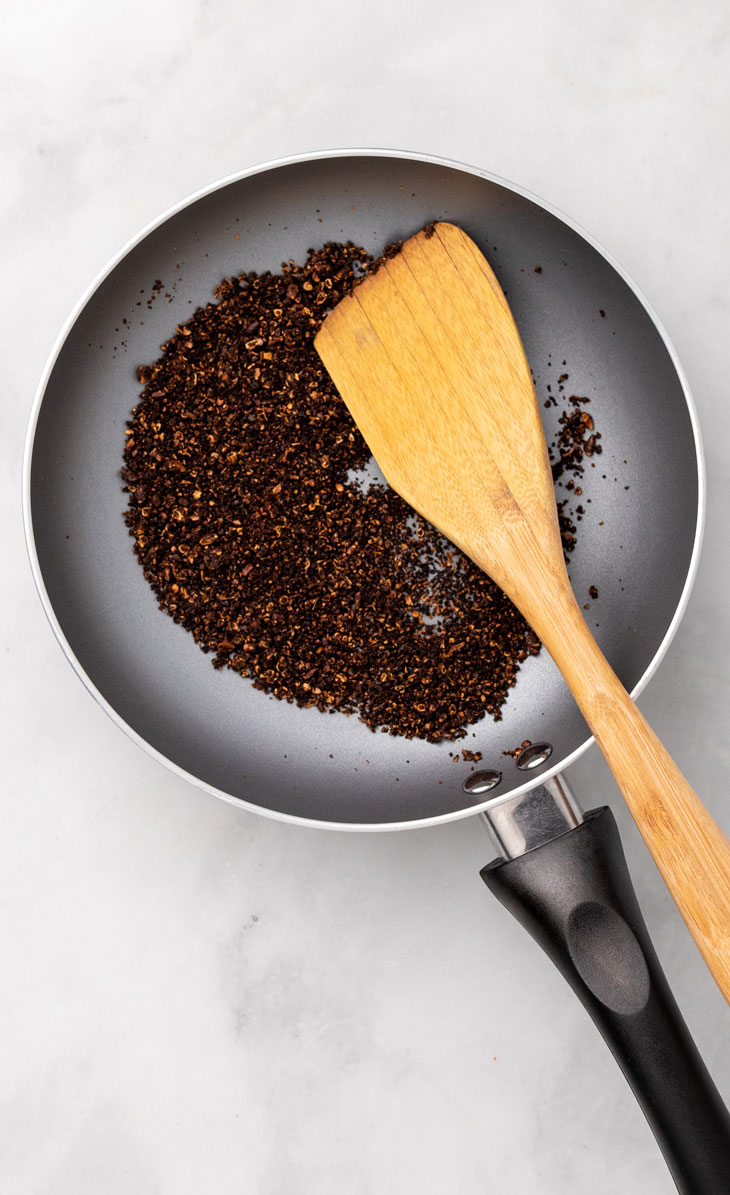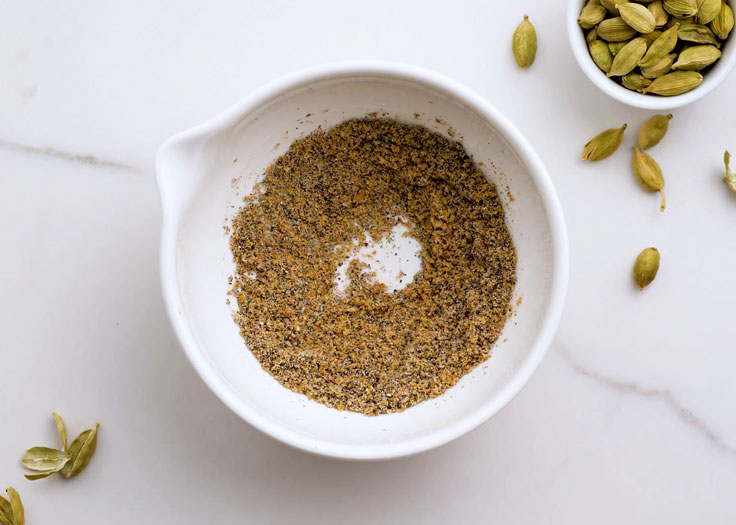Whole Spices vs. Ground Spices
When it comes to spices, I prefer to buy whole spices and grind them myself using an inexpensive coffee or spice grinder though mortar pestle works too. Whole spices last longer and maintain their flavor longer than pre-ground spices. They’re also cheaper to purchase when you buy in bulk. Using ground spices can reduce prep time, and if you use them regularly and continue to re-stock, you don’t have to worry as much about the loss of flavor. Once you stock your kitchen with whole spices, they should last you a while. People often mistake Indian food for being a complicated cuisine. I think part of the reason for this myth is due to the long list of unfamiliar ingredients that accompany most recipes. Once you familiarize yourself with the ingredients, you’ll be set to cook any Indian dish! I’ve created an Indian Cooking section in my blog’s shop that you can check out. You can find a lot of what’s listed below in the shop.
Gather spices before cooking
When it comes to cooking Indian cuisine, read through the recipe once before starting. Gather all of the spices together in a small bowl so that when the instructions call for them, you’re not searching for several jars of spices at once. Prepping the ingredients beforehand can save you a lot of time and stress when preparing a meal. It can also help keep spices from burning.
What does it mean to temper spices? What is a tadka?
If you’re familiar with Indian cooking, you’ve probably heard of the word tempering or tadka or vaghar or chhonk. They’re all the same word for an Indian technique where you sizzle spices in hot fat like oil or ghee. This infuses the oil and makes spices more aromatic.
An Overview of Indian Spices
This is by no means an exhaustive list of all of the spices used in Indian Cooking. If I forgot to list a spice that you’d like to know more about, leave me a comment! Also, these are in alphabetical order, not in the order of what’s used most.
Anardana powder:
Anardana powder is ground up dried pomegranate seeds. This is a fruit used more like a spice to add a slightly fruity, tangy, and vibrant flavor to recipes. Some recipes (like my chikar cholay) call for roasting the powder first, making it very dark brown, nearly black in color; this helps add flavor and color to a dish.
Amchur powder (dried green mango powder):
Amchur or Amchoor Powder is made from unripe green mangoes. It adds a tart and fruity flavor to recipes.
Bay leaf (Indian bay leaf, Tej Patta)
Indian bay leaves are longer and thinner than bay laurel leaves which are more commonly found in American grocery stores. Bay leaves break down as they cook and impart an herbal aroma to a dish.
Black cardamom:
Black Cardamom is larger than green cardamom and not as commonly used. It has a potent smoky aroma; use sparingly.
Black pepper (kali mirch)
It’s easy to overlook black pepper among all of the other spices used in Indian cooking, however, black pepper is very important to Indian cuisine. It’s the only pepper believed to be native to India and so originally, this is the spice that gave Indian food its heat. Some recipes call for whole black peppercorns and some call for ground black pepper. I suggest buying whole black peppercorns and grinding them yourself as the flavor is much more intense compared to store-bought pre-ground black pepper.
Black salt (kala namak):
Black salt (kala namak) is an Indian volcanic rock salt that is pinkish-grey in color and has a distinct salty, pungent, sulfurous aroma and flavor. It’s a spice that’s sometimes used in vegan recipes to mimic the taste of hard-boiled egg. It’s also often used in chutneys and chaat.
Brown or black mustard seeds:
Brown/Black Mustard Seeds are commonly used in Indian cooking and are more intense than yellow mustard seeds. Brown or black mustard seeds are typically first cooked in hot oil until they begin to pop or splutter. They are pungent, slightly spicy, and nutty.
Cardamom:
Cardamom (green) is warm, floral, and aromatic. It’s one of my favorite spices to use in sweets and also in savory dishes. The flavor and aroma of freshly ground cardamom is far more intense than store-bought ground cardamom. You can get away with store-bought ground cardamom in curries if necessary, but I highly suggest grinding your own cardamom, especially for desserts! Some recipes like chai or pulao or biryani will call for the whole cardamom, so be sure to keep those on hand as well.
Chaat Masala
Chaat masala is a salty and tangy spice blend used in chaat (Indian street food) dishes. It typically contains ingredients like black salt, fennel, cumin. Chaat masala can be an acquired taste for some but those who enjoy it, truly love its chatpata (spicy and tangy) flavor.
Cloves:
Cloves have a uniquely sweet and warm aroma, making them perfect for sweet and savory dishes.
Coriander:
Unlike cilantro leaves, coriander seeds are mild in flavor. Even if you’re a cilantro hater, give the seeds a chance. I find that coriander seeds to be sweet and nutty with subtle notes of lemon.
Cumin:
Cumin, a member of the parsley family, and has an earthy and smoky flavor. By first dry roasting the seeds in a skillet, you can intensify this flavor. Please also see “Roasted Cumin Powder” section below.
Curry leaves:
Curry leaves are from a plant, and they provide dishes with a unique smoky and citrus-like flavor and aroma. You can find fresh curry leaves at most Indian grocery stores or on amazon. I typically store extra leaves in a ziplock bag in my freezer and use them as needed (see my blog post on curry leaves vs. curry powder).
Curry powder:
Curry Powder is a name coined by the British during their rule over India. It refers to a blend of Indian spices that typically calls for coriander, cumin, turmeric, red chili powder as well as other spices. Curry powder does not contain curry leaves. (See my blog post on curry leaves vs. curry powder).
Fennel seeds:
Fennel Seeds: Fennel seeds are highly aromatic and have a sweet, licorice-like flavor.
Fenugreek leaves (kasoori methi):
Fenugreek Leaves (dried, also known as Kasoori Methi): This is the secret to getting homemade Indian food to taste restaurant quality. Dried fenugreek leaves (also known as kasoori methi) adds complex flavor to any curry or dish. It’s earthy, warm, sweet, and bitter. You can find dried fenugreek leaves at any Indian store and also on amazon.
Fenugreek seeds:
Fenugreek Seeds (methi seeds): fenugreek seeds have a bitter flavor and cannot be used as a substitute for dried fenugreek leaves.
Garam masala (north and south blends):
Garam Masala vs. Meat Masala: You will see both of these spice blends used on my website – they are not interchangeable. The garam masala that you find in stores is typically a north Indian blend. My homemade meat masala is different in flavor and is primarily used in south Indian cooking. Please make sure to use the right masala according to the recipe.
Hing (Asafoetida):
Hing (Asafoetida) is a spice that has a robust flavor reminiscent of garlic and onion and is often used as a substitute for those two ingredients. Hing adds an umami flavor to recipes and can be potent, so use sparingly. It also has a reputation for helping with digestion. Powdered hing is often blended with another ingredient, mostly wheat flour, so check the ingredients if you are gluten-free.
Kalonji (nigella seeds):
Kalonji (Nigella Seeds): Kalonji, also known as nigella seed or as onion seed, are small, black, triangular-shaped seeds that look similar to sesame seeds. They’re nutty, peppery, and pungent. They are often used in pickle or chutney recipes, and some restaurants will even add kalonji to naan bread.
Kashmiri chili powder:
Kashmiri Chili Powder vs. Cayenne: Cayenne is a spicy chili pepper that will add heat to a dish. It ranges from 30k-50k Scoville units. Kashmiri chili powder, on the other hand, is very mild and registers at around 2k Scoville units. Many recipes call for Kashmiri chili powder because it adds a bright and vibrant red hue to dishes. If you’re looking to substitute Kashmiri chili powder, then I suggest using paprika.
Mustard oil:
Mustard Oil: Mustard oil has a horseradish or wasabi-like flavor and is very pungent, so a little goes a long way. Mustard oil is popular in Indian and South Asian cuisine; however, it can only be sold as “massage” oil in the United States due to the erucic acid found in this oil. That said, this oil is becoming increasingly more popular, even among American chefs. You can purchase this oil in any Indian grocery store or on amazon.
Roasted cumin powder:
Roasted Cumin Powder is also known as bhuna jeera powder, is highly aromatic and has a more intense flavor than regular cumin. It’s a bit nutty and adds a unique flavor to recipes. Read this post to learn how to make this powder.
Saffron:
Saffron: Saffron, one of the most expensive spices on the market, requires just a pinch to impart its flavor and beautiful golden color onto any dish. Soak a couple of saffron threads in a tablespoon or two of warm water or milk before using it.
Star anise:
Star Anise: This star-shaped spice has a licorice-like flavor. While star anise and fennel seed are somewhat similar in flavor, I find star anise to be savory and slightly bitter, whereas I consider fennel seed to be sweeter.
Tamarind
Tamarind is sold as a paste and not a spice, but like a spice, it is used to add flavor to recipes. It is fruity and tangy.
Turmeric:
Turmeric, one of the most popular Indian spices, has a long history of medicinal use dating back thousands of years. It has a warm, peppery, bitter flavor and will add a bright yellow color to any dish. If you missed the previous Indian 101 “class,” check out this post: Curry Leaves vs. Curry Powder




